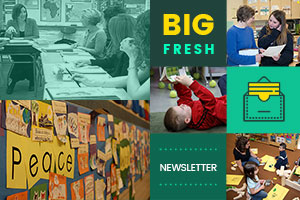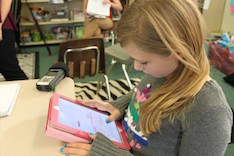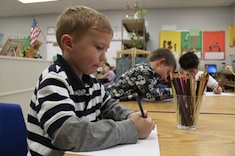Library
Choice Literacy Articles & Videos
The Choice Literacy library contains over 3,000 articles and 900 videos from 150+ contributors. Classic Classroom and Literacy Leadership subscribers have access to the entire library. Content is updated continuously, with five to six new features published each week.
Latest Content
January 26, 2024: Finding Joy in Learning
This week’s newsletter is about prioritizing joy in school.
Kintsugi
Given an assignment to break a china bowl and rebuild it allowed Gretchen Schroeder to engage in the Japanese art of kintsugi. What surprised her were the lessons she learned about growth and innovation in her teaching practice.
Reclaiming Our Time
Vivian Chen gives four steps to adjusting a lesson from the teacher’s guide to reclaim your time and make the lesson more meaningful and engaging to students.
January 19, 2024: Research Notes
This week’s newsletter is about students collecting research notes.
Increasing Engagement During Online Practice Opportunities
Mallory Messenger is intentional about monitoring and supporting cognitive engagement while students use online practice tools. Use her tips so your students are engaged too!
Bet You Didn’t Know: Chicken Eggs and Research
Mandy Robek encourages young writers to collect information about a topic. She provides whole-class and individual structures for students to learn that their understanding can change, as well as to be able to access information when they are ready to draft. Don’t miss Mrs. Robek’s digital class book.
Color Coding: An Organizational Strategy
Leigh Anne Eck gives advice to her middle school writers for collecting research notes.
January 12, 2024: Poetry
This week’s newsletter is about poetry.
Poetry Friday Stretches Into Poetry Slam
Mandy Robek shares an update to her Poetry Friday routine inspired by the professional book Artfully Teaching the Science of Reading by Chase Young, David Page, and Timothy V. Rasinski. You, too, will want to incorporate this poetry routine into your week.
Poetry Strategies for Partners and Groups
Gretchen Schroeder offers three ideas for partners or small groups to engage with poetry. Not only will they get creativity flowing, but they will also lift writers’ energy.
December 22, 2023: 10 Articles from 2023
This week’s newsletter is a roundup of 10 articles from 2023.
December 15, 2023: Top Issues from 2023
This week’s newsletter is a roundup of issues from 2023.
December 8, 2023: Curiosity
This week’s newsletter is about curiosity.
Stay Curious
Inspired by Ted Lasso’s mantra, “Stay curious, not judgmental,” Julie Cox provides three questions she asks herself and students to remain innovative.
Sparking Curiosity: Developing Ownership of Learning Through “What If” Questions
Jodie Bailey encourages us to use “What if” questions in all content areas to give students the space to use their innate curiosity to engage in meaningful learning.
December 1, 2023: Care and Compassion
This week’s newsletter is about care and compassion.
Detours: A Reminder of the Humanity of Students
Gretchen Schroeder reminds us of the importance of checking in with students and gauging how they are feeling—and then responding with authenticity and joy.
Increasing Student Choice
We want students to be lifelong learners, eager to grow, and equipped to face challenges. For this to happen, we have to let the classroom be a place that reflects these qualities. Julie Cox offers three innovative ways to leave choice in the hands of students. In turn, they learn to trust themselves and their learning, and believe that they are capable of finding answers.
November 17, 2023: Supporting Writers
This week’s newsletter is about supporting writers.
Minilessons and Writing Instruction
Katie Linder reminds us of the importance of writing lessons to be predictable, efficient, and student-centered.
Plagued by Plagiarism
Plagiarism is an age-old issue, but with the emergence of AI tools, it’s plaguing our classrooms again. Vivian Chen offers three practical (and essential) approaches when working with writers.
November 10, 2023: Beat Overwhelm!
This week’s newsletter is about beating overwhelm!
Dealing with Overwhelm
Julie Cox offers three actionable ideas to fight frustration and take small steps to beat overwhelm.
November 3, 2023: Reading Instruction
This week’s newsletter is about reading instruction.
Three Archetypes as Advocates for the Science of Reading
Matt Renwick defines three archetypes of personalities he has observed who have incomplete understandings about the science of reading. Matt offers approaches to each person, and notes that no one person neatly fits into a simple archetype.
October 20, 2023: Tools to Empower Engagement
This week’s newsletter is about tools that empower engagement.
Creating a Teacher Notetaking System
Dana Murphy, a reading specialist, guides all teachers in ways to develop a notetaking system that works perfectly because it is personalized.
Anchor Charts: A Tool for Every Classroom
Leigh Anne Eck reflects on the importance of anchor charts and the way they help students be more independent.
October 13, 2023: Listening To and Hearing Students
This week’s newsletter is about listening to and hearing students.
October 6, 2023: Building Identity
This week’s newsletter is about building identity.
Browse Content By
Type
Category
- Assessment Tools
- Big Fresh Archives
- Booklists
- Choice Numeracy
- Classroom Design
- Common Core
- Community Building
- Conferring
- Content Literacy
- Digital Literacy
- English Language Learners
- Equity
- Family Relations
- Free Samples
- Guiding Groups
- Leadership
- Literacy Coaches
- Mentor Texts
- Minilessons
- New Teacher Mentors
- Podcasts
- Poetry
- Quote Collections
- Reading Strategies
- Self Care
- Struggling and Striving Learners
- Talking and Listening
- Teacher Study Groups
- Teaching Reading
- Teaching Writing
- Word Study and Vocabulary
Author
- Melissa Quimby
- Nawal Qarooni
- Gwen Blumberg
- Julie Cox
- The Lead Learners
- Hannah Tills
- Josie Stewart
- Ruth Metcalfe
- Mallory Messenger
- Becca Burk
- Jodie Bailey
- Vivian Chen
- Mary Brower
- Tiffany Abbott Fuller
- Stephanie Affinito
- Ruth Ayres
- Leigh Anne Eck
- Heather Fisher
- Shari Frost
- Julie Johnson
- Suzy Kaback
- Gigi McAllister
- Shirl McPhillips
- Melanie Meehan
- Cathy Mere
- Debbie Miller
- Tara Barnett and Kate Mills
- Tammy Mulligan
- Dana Murphy
- Bitsy Parks
- David Pittman
- Brenda Power
- Heather Rader
- Matt Renwick
- Mandy Robek
- Christy Rush-Levine
- Gretchen Schroeder
- Jen Schwanke
- Brian Sepe
- Katherine Sokolowski
- Stella Villalba
- Jennifer Vincent
Grade Level
Choice Literacy Membership
Articles
Get full access to all Choice Literacy article content
Videos
Get full access to all Choice Literacy video content
Courses
Access Choice Literacy course curriculum and training



















